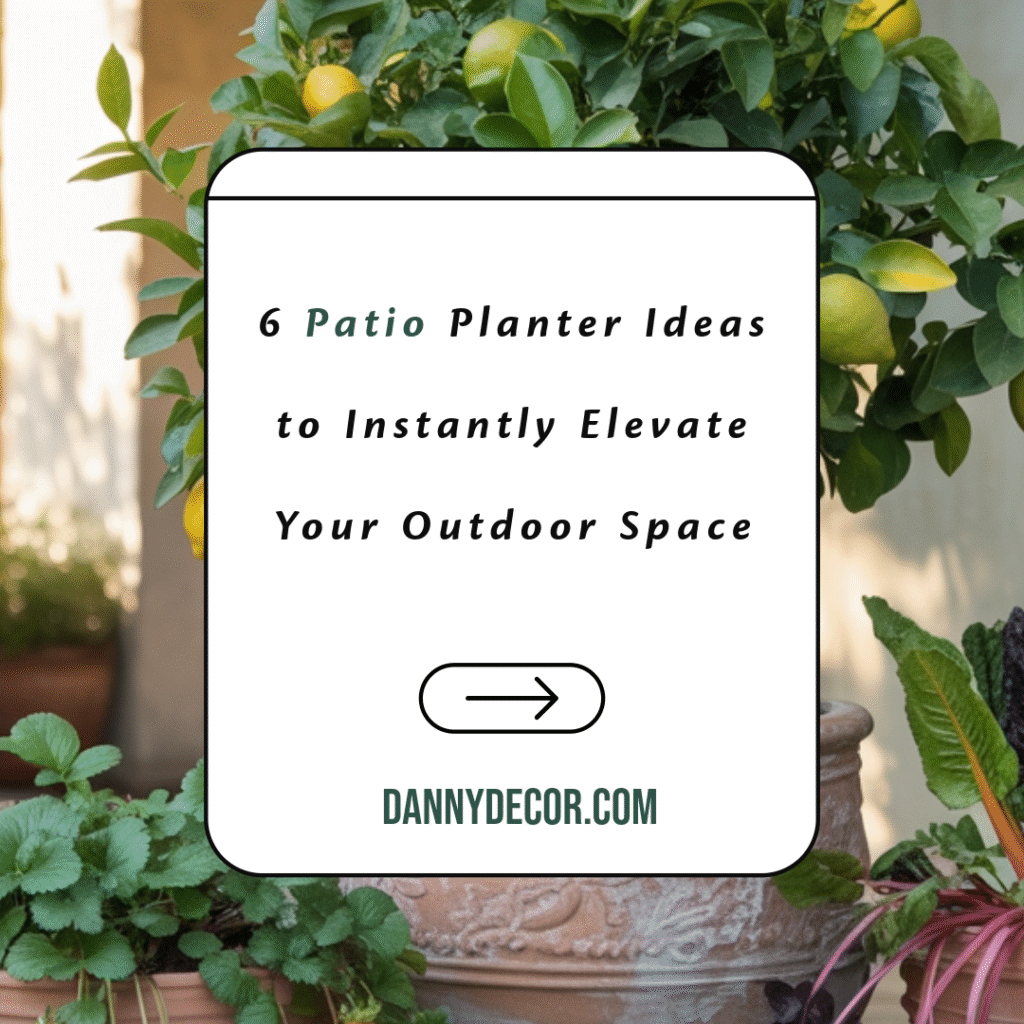
Your patio holds incredible potential that most homeowners never fully realize. Instead of treating it as an afterthought or storage area, imagine stepping outside to a space that feels like a natural extension of your living room. The secret lies in strategic planter placement and thoughtful plant selection that creates layers of beauty and functionality.
Planters offer unique advantages over traditional garden beds. They provide complete control over soil quality, drainage, and plant placement. You can rearrange them seasonally, experiment with different combinations, and even bring tender plants indoors during harsh weather. This flexibility makes patios with planters more dynamic and personally expressive than static landscapes.
The psychological benefits of surrounding yourself with greenery extend far beyond aesthetic appeal. Studies consistently show that exposure to plants reduces stress, improves air quality, and enhances overall well-being. When your outdoor space becomes a lush retreat, you naturally spend more time there, leading to better relaxation and social connections.
Understanding Your Patio’s Potential
Every patio has unique characteristics that influence planter success. Sun exposure determines which plants will thrive versus struggle in your specific location. Morning sun with afternoon shade suits most flowering plants, while full sun areas accommodate succulents and Mediterranean herbs beautifully.
Wind patterns affect both plant health and container stability. Exposed locations require heavier planters and wind-resistant plant varieties. Sheltered areas allow for more delicate arrangements and lighter containers that can be moved easily for maintenance or seasonal changes.
Size constraints shouldn’t limit your creativity. Small patios benefit from vertical arrangements and multi-level displays that maximize growing space without overwhelming the area. Large patios can accommodate dramatic groupings and specimen plants that create focal points and define different zones.
Consider your maintenance preferences honestly before selecting plants and container styles. High-maintenance arrangements with frequent watering and deadheading requirements work well for dedicated gardeners. Busy homeowners should focus on drought-tolerant plants and self-watering containers that provide beauty without demanding daily attention.
1. The Modern Minimalist Statement
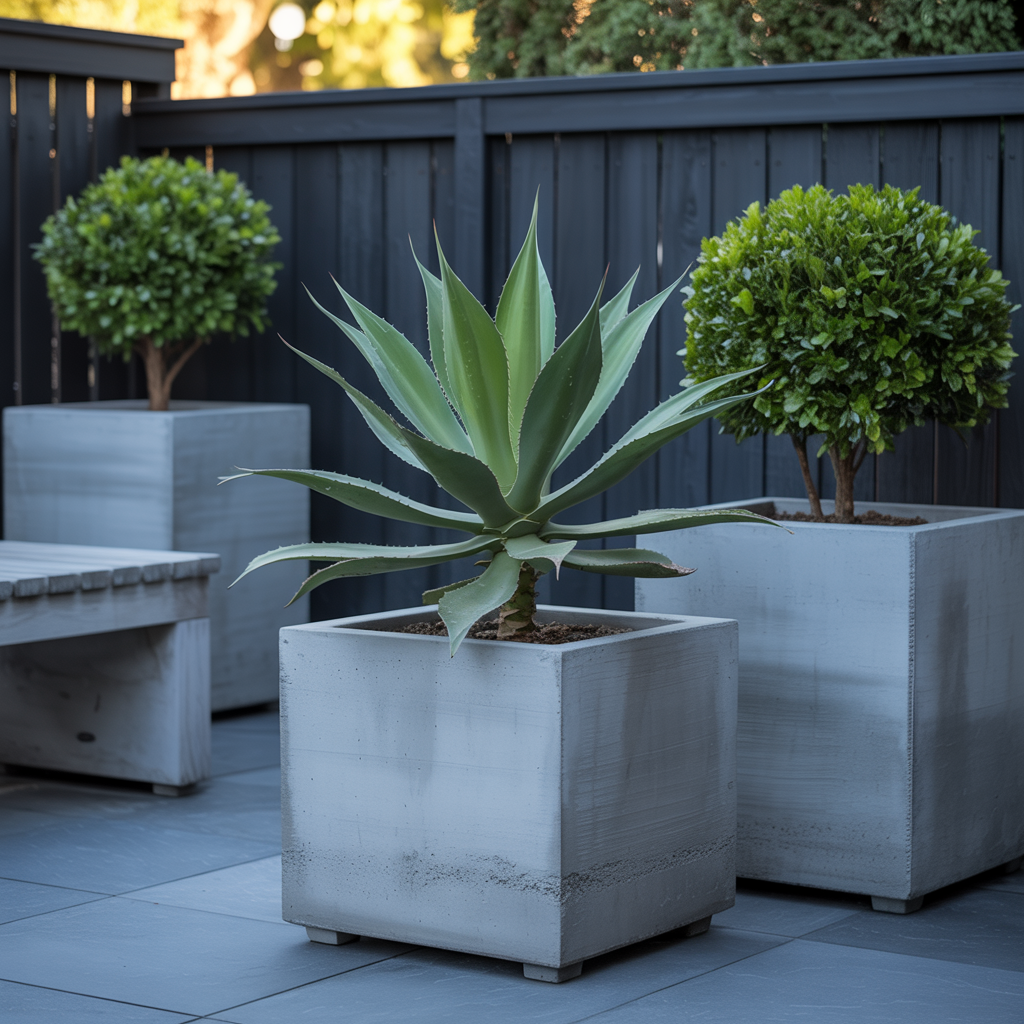
Clean lines and architectural plants create sophisticated outdoor spaces that complement contemporary home designs. Modern planters in geometric shapes using materials like concrete, steel, or fiberglass provide strong visual anchors without competing with plant forms for attention.
Plant selections should emphasize structure and form over busy flower displays. Ornamental grasses add movement and texture while maintaining year-round interest. Architectural plants like agave, yucca, or carefully pruned boxwood create living sculptures that look intentional and designed.
Color palettes work best when kept simple and sophisticated. Monochromatic schemes using different shades of green create calm, cohesive displays. Single accent colors like deep purple or bright orange can be introduced through carefully selected flowering plants or decorative elements.
Container groupings should follow odd-number rules and vary in height while maintaining similar styles and materials. Three large planters of different sizes create more dynamic arrangements than matched pairs. Negative space between containers becomes as important as the planted areas for achieving balanced compositions.
2. The Cottage Garden Abundance
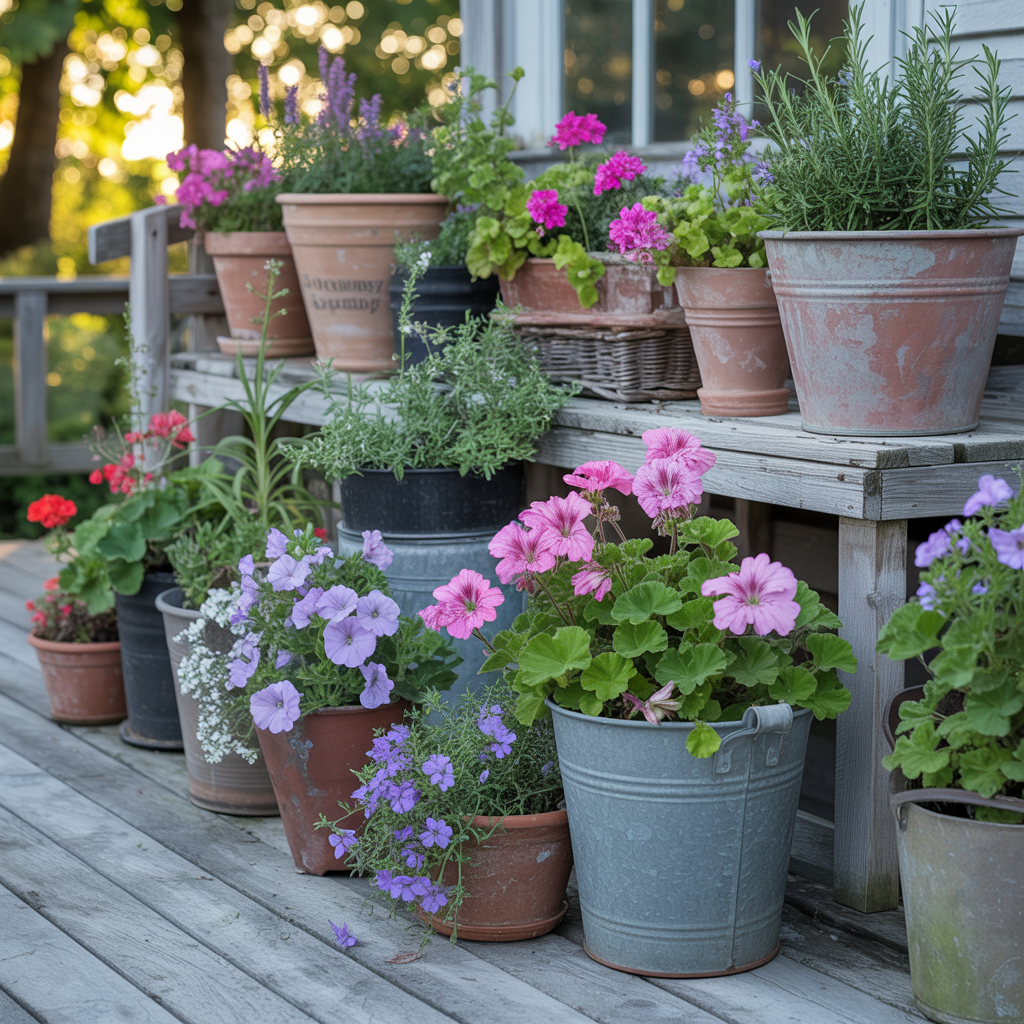
Cottage-style planters embrace the “more is more” philosophy with overflowing arrangements that feel romantically abundant. Mixed plantings combine flowers, herbs, and trailing plants in seemingly casual arrangements that actually require careful planning to achieve the desired effortless appearance.
Traditional materials like terracotta, aged wood, and galvanized metal containers enhance the cottage aesthetic. Weathered finishes and patina add character that new containers lack. Repurposed items like vintage buckets, ceramic crocks, or wooden crates create unique planters with built-in charm and conversation value.
Plant combinations should include different heights, textures, and flowering seasons to maintain interest throughout the growing period. Tall spikes of delphinium or foxglove provide vertical elements. Rounded forms like geraniums or petunias fill middle spaces. Trailing plants like ivy geranium or bacopa cascade over container edges.
Herbs integrated throughout cottage arrangements provide practical benefits alongside ornamental value. Lavender adds fragrance and attracts beneficial insects. Rosemary provides evergreen structure and culinary utility. Thyme creates fragrant carpets that release scent when brushed against.
3. The Tropical Paradise Escape
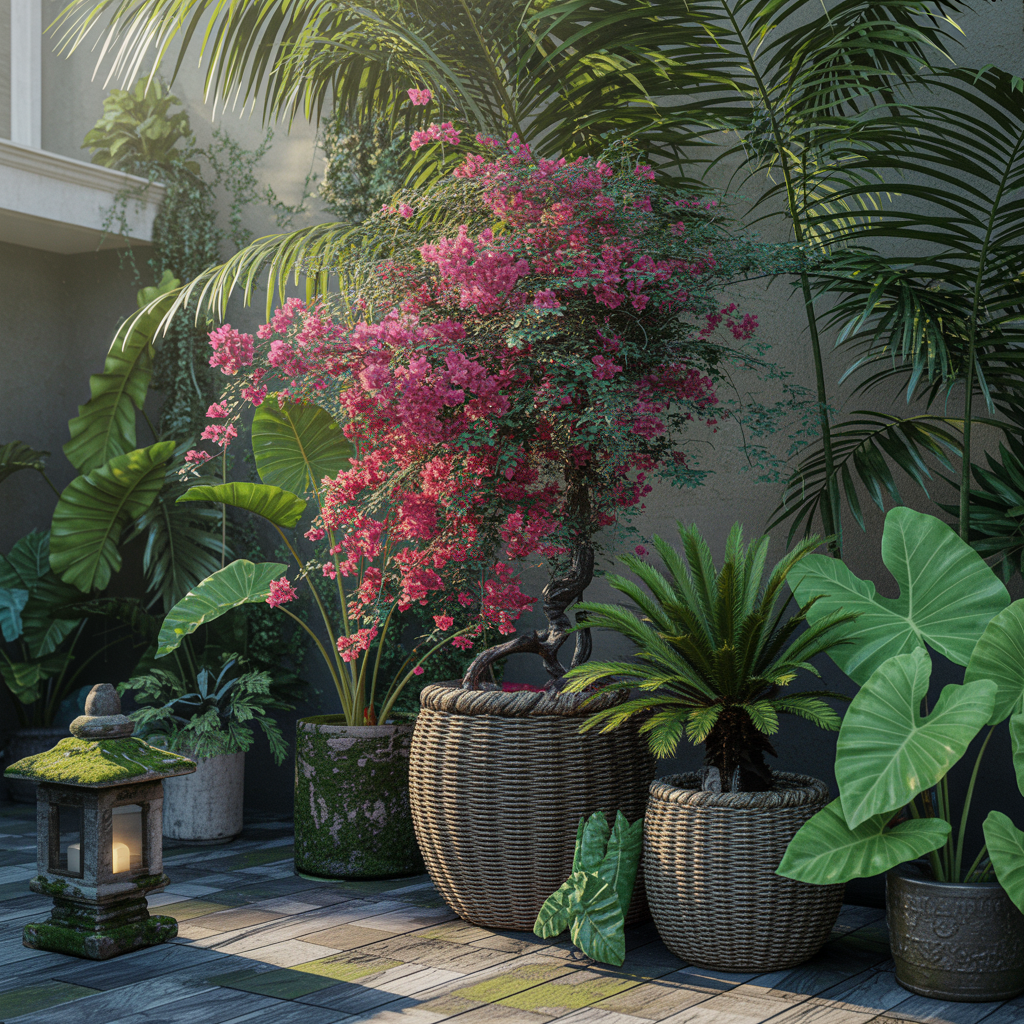
Tropical-themed planters transform ordinary patios into exotic retreats that feel like vacation destinations. Large-leafed plants create dramatic focal points while smaller tropical species add layers of texture and color that transport you mentally to warmer climates.
Container choices should complement the tropical theme using natural materials like bamboo, teak, or woven fibers. Earth tones and natural textures allow plant colors and forms to dominate the visual impact. Large containers accommodate the root systems that tropical plants require for healthy growth.
Plant selections can include both true tropicals and temperate plants with tropical appearances. Palm varieties adapted to container growing provide classic tropical silhouettes. Elephant ears create dramatic foliage displays. Hibiscus and bougainvillea add bright flowering elements that scream tropical paradise.
Layering different plant heights creates the jungle-like density that makes tropical arrangements feel authentic. Tall palms or tree ferns provide canopy elements. Medium-height plants like caladiums or crotons fill middle layers. Ground-covering plants like coleus or begonias complete the layered effect.
4. The Edible Landscape Integration
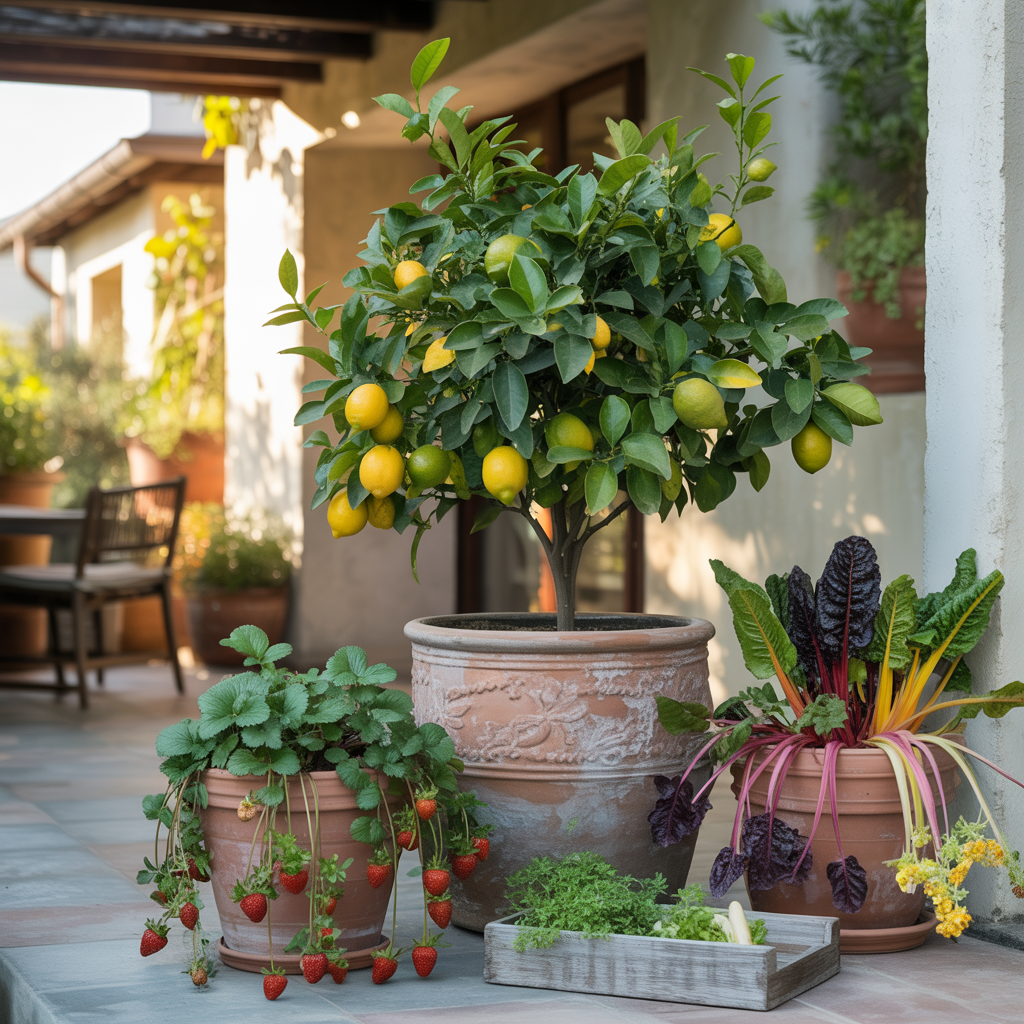
Combining ornamental and edible plants creates patios that feed both body and soul. Edible landscaping proves that productive gardens can be as beautiful as purely decorative ones while providing fresh ingredients for cooking and entertainment.
Herb planters offer the easiest entry into edible landscaping since most culinary herbs are naturally attractive and aromatic. Mediterranean herbs like rosemary, oregano, and sage thrive in containers while providing year-round structure and seasonal flowering. Tender herbs like basil and cilantro can be grown in moveable containers for season extension.
Vegetable selections should prioritize attractive varieties that provide ornamental value alongside food production. Rainbow chard offers colorful stems and leaves. Purple kale creates dramatic foliage displays. Cherry tomatoes cascade beautifully from hanging containers while producing abundant harvests.
Fruit options for container growing include compact varieties bred specifically for small spaces. Dwarf citrus trees provide evergreen structure, fragrant flowers, and colorful fruit. Blueberry bushes offer spring flowers, summer fruit, and fall color. Strawberry plants work well in tiered arrangements or hanging containers.
5. The Seasonal Transition Display
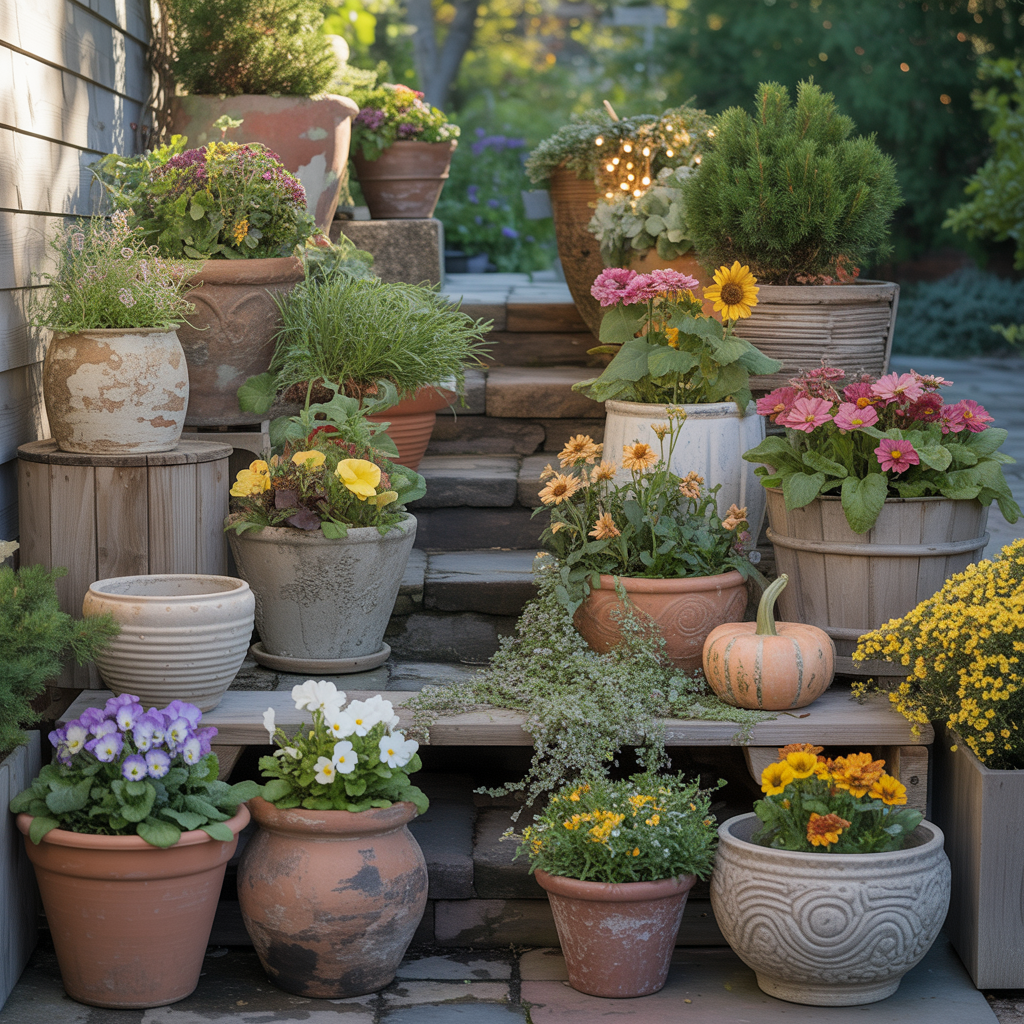
Smart seasonal planning keeps patios interesting throughout the year by rotating plants and containers based on growing seasons and weather conditions. This approach maximizes the investment in containers while providing constantly changing displays that reflect natural seasonal rhythms.
Spring arrangements should emphasize fresh growth and early flowering plants. Cool-season annuals like pansies, primrose, and snapdragons provide color during cooler months. Bulbs planted in containers force early blooms that signal winter’s end. Fresh green foliage creates optimistic displays after winter dormancy.
Summer displays can handle the heat and intense sunlight that defeat spring plantings. Heat-loving annuals like marigolds, zinnias, and sunflowers thrive in containers during hot months. Tropical plants moved outdoors for summer create exotic displays. Drought-tolerant plants reduce watering demands during peak heat periods.
Fall transitions should celebrate the season’s unique colors and textures. Chrysanthemums provide classic autumn colors in container-friendly forms. Ornamental cabbages and kales offer cool-weather beauty. Seasonal decorations like pumpkins and gourds integrate with plant displays for holiday appeal.
Winter arrangements require careful plant selection for cold-hardy varieties that maintain interest during dormant seasons. Evergreen plants provide consistent structure and color. Berry-producing plants like winterberry holly add seasonal interest. Decorative elements like lights or seasonal containers maintain visual appeal when plant growth slows.
6. The Vertical Garden Revolution
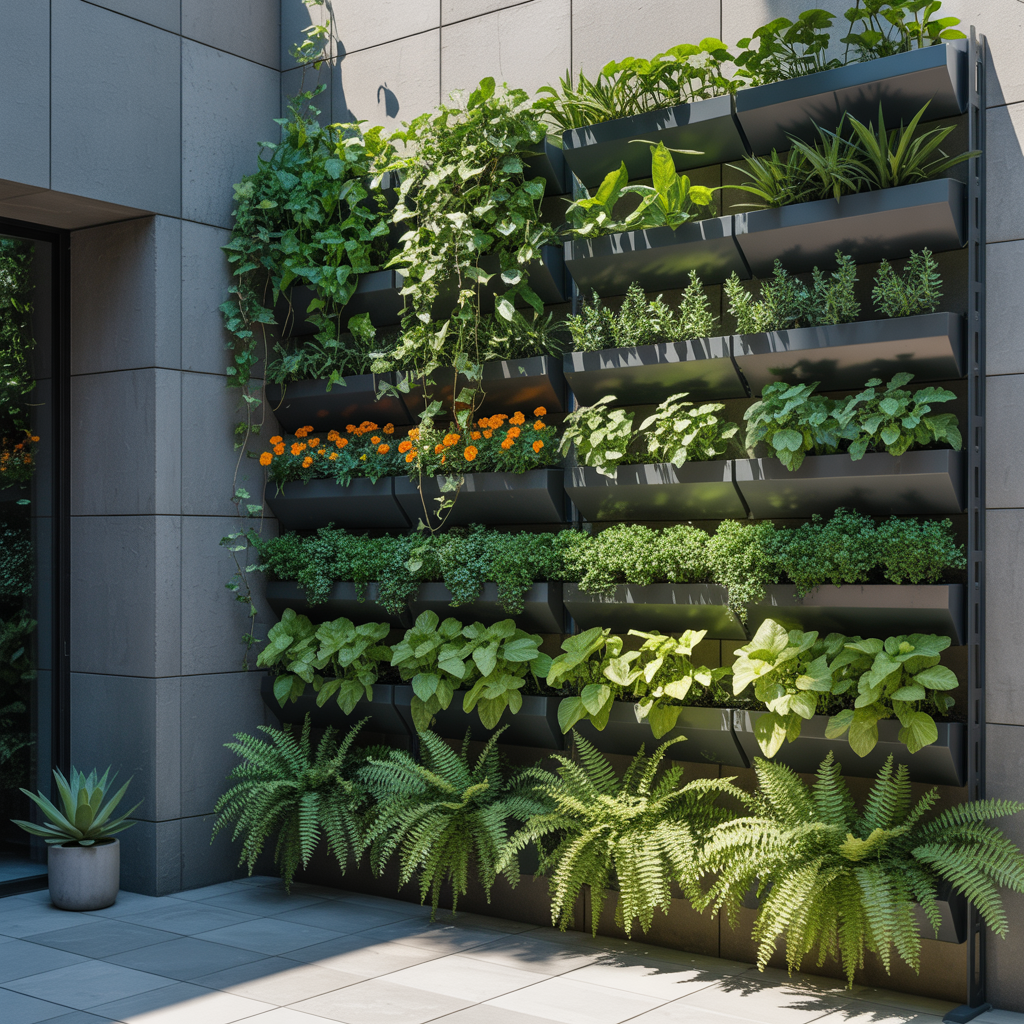
Vertical planter arrangements maximize growing space while creating dramatic visual impact that draws the eye upward. These installations work particularly well for small patios where horizontal space is limited but wall space offers untapped potential for plant displays.
Structural considerations require secure mounting systems that can support the weight of soil, plants, and water. Wall-mounted systems need adequate drainage to prevent moisture damage to building surfaces. Freestanding vertical structures offer flexibility but require stable bases to prevent tipping.
Plant selections for vertical arrangements should consider different light levels and watering needs at various heights. Top positions receive the most light and dry out fastest. Bottom positions stay moister but may receive less direct sunlight. Trailing plants at upper levels create cascading effects that soften rigid structures.
Irrigation systems become crucial for successful vertical gardens since hand-watering can be difficult and uneven. Drip irrigation systems provide consistent moisture delivery to all levels. Self-watering containers reduce maintenance demands. Gravity-fed systems work well for smaller installations without requiring electricity.
Creating Your Perfect Patio Paradise
Successful patio transformations happen gradually through experimentation and seasonal adjustments. Start with one or two planter arrangements that address your most important needs or preferences. Learn what works in your specific conditions before expanding to more complex installations.
Budget considerations should balance initial investment with long-term satisfaction and maintenance costs. Quality containers last for years and justify higher initial expenses. Plant investments can be spread across seasons as you add new elements and replace seasonal displays.
Maintenance planning ensures your beautiful arrangements remain attractive throughout their growing seasons. Regular watering, fertilizing, and deadheading requirements vary significantly between different planter styles and plant combinations. Choose arrangements that match your available time and gardening interest levels.
Remember that the best patio planter designs reflect your personal style and functional needs rather than following trends exactly. Your outdoor space should feel like an extension of your personality and provide the specific benefits you value most. Whether that means fragrant herbs for cooking, colorful flowers for visual impact, or low-maintenance succulents for easy care, the right combination exists for every homeowner and every patio.

Add a Comment